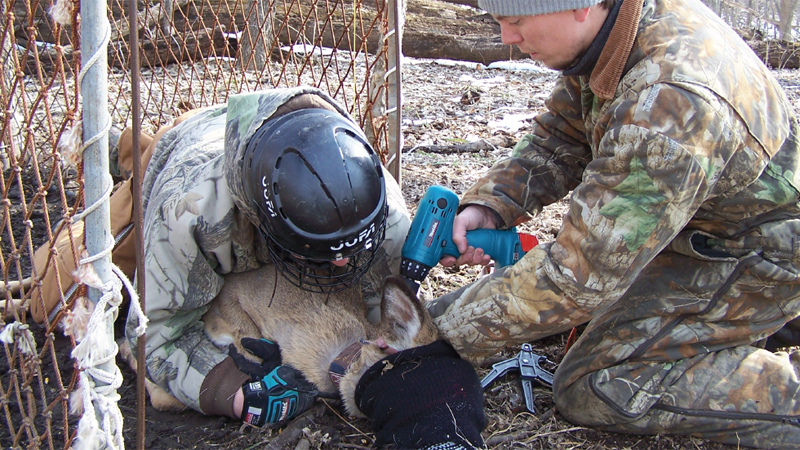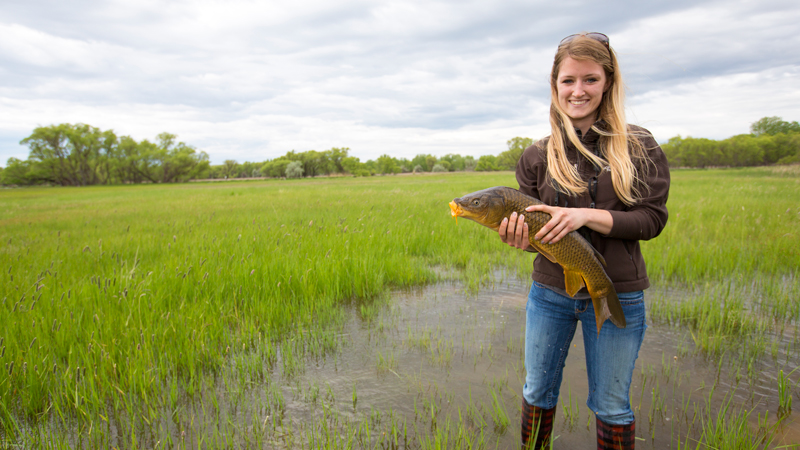Applied Ecology Specialization in
Natural Resource Sciences Graduate Program
Available to MS and PhD candidates.
Students in the Applied Ecology specialization focus on the interactions among ecosystem components. This specialization is designed for students interested in applying ecological principles to the management of terrestrial and aquatic ecosystems.
The School of Natural Resources is an academic unit in the Institute of Agriculture and Natural Resources at the University of Nebraska-Lincoln. Most faculty and graduate students in the School reside in Hardin Hall on UNL’s East Campus. The building has excellent laboratory, office, and classroom facilities to support research, teaching and outreach activities.
Faculty members within the Applied Ecology specialization have strong cooperative efforts with other departments and colleges. Graduate students seeking a MS or PhD specialization in Applied Ecology from SNR will find a variety of options available to help tailor the program to their unique interests.
Educational goals and objectives:
- Provide students a learning environment to promote a broad understanding of ecological principles and how they can be applied to the conservation and management of our natural resources.
- Recognize students who have attained an advanced knowledge of ecological science and management.
- Support interactions and cooperation among the community of scientists and students working on applied ecological problems.
Scope:
While there are no specific guidelines or national accreditation programs, students will be encouraged to seek a broad background in several areas focusing on interactions among ecosystem components. The specialization is designed for students interested in applying ecological principles to the management of terrestrial and aquatic ecosystems. The specialization should appeal to students interested in
- agroforestry/agroecology
- aquatic ecology
- fisheries ecology
- stream ecology
- conservation biology
- forest ecology
- grassland ecology
- wildlife ecology
- ecosystem science
Faculty Point-of-Contact
If you are interested in the Applied Ecology graduate specialization, please feel free to contact the following SNR faculty member:
Advising Faculty
- Craig Allen
- Lord Ameyaw
- Matt Andrews
- John Benson
- Mark Burbach
- John Carroll
- Chris Chizinski
- Jessica Corman
- Jenny Dauer
- Joe Dauer
- John Gamon
- Leon Higley
- Clint Leach
- Andrew (Andy) Little
- Keeley MacNeill
- Rene Martin
- Nicholas McMillan
- Gwendŵr Meredith
- Jill Motschenbacher
- Mark Pegg
- Lisa Pennisi
- Larkin Powell
- Sarah Sonsthagen
- Jonathan Spurgeon
- Dan Uden
- Elizabeth (Liz) VanWormer
- Mark Vrtiska
- Dave Wedin
- Bob Zink
Admission Requirements
Please see our admission requirements and application procedure pages for more information about our admission and application expectations for graduate degree candidates.
Graduation Requirements
Master of Science
- Thirty (30) hours of graduate courses are required for the degree.
- Individualized programs are developed by the student and their supervisory committee in accordance with the requirements of the M.S. in Natural Resource Sciences degree as detailed in the Graduate Studies Bulletin. Students are encouraged to take a broad array of classes that will provide the background to address ecosystem issues from various perspectives.
- Student must complete a thesis research topic in Applied Ecology.
- Student must complete NRES 801 (2 cr).
- The chair (or one co-chair) of the student’s supervisory committee must be a faculty member from the Applied Ecology Group and a member of the UNL graduate faculty.
- At least two courses of the program must be “NRES” courses or a substitute course approved by the Applied Ecology faculty.
Doctor of Philosophy
- Ninety (90) hours of graduate courses are required for the degree.
- Individualized programs are developed by the student and their supervisory committee in accordance with the requirements of the Ph.D. in Natural Resource Sciences degree as detailed in the Graduate Studies Bulletin. Students are encouraged to take a broad array of classes that will provide the background to address ecosystem issues from various perspectives.
- Student must complete a dissertation research topic in Applied Ecology.
- Student must complete NRES 801 (2 cr).
- The chair (or one co-chair) of the student’s supervisory committee must be a faculty member from the Applied Ecology Group and a member of the UNL graduate faculty.
- At least three courses of the program must be “NRES” courses or a substitute course approved by the Applied Ecology faculty.
Career Opportunities
The specialization should appeal to students interested in academic, state/federal agency, NGO, and professional careers in
- agroforestry/agroecology
- aquatic ecology
- fisheries ecology
- stream ecology
- conservation biology
- forest ecology
- grassland ecology
- wildlife ecology
- ecosystem science


Selected Dissertations & Theses
Microbiome-Mediated Conservation: Exploring Gut Microbial Composition in Wild and Hatchery-Reared Pallid Sturgeon and the Role of Probiotics in Recovery Practices - Israt Jahan
- Dissertation Defense
- 07/17/2025
The Pallid Sturgeon (Scaphirhynchus albus), a long-lived, benthic fish that has inhabited the Mississippi–Missouri River system for over 70 million years, plays a vital ecological role. However, extensive habitat degradation and limited natural recruitment have pushed the species to the brink of extinction, prompting large-scale conservation efforts centered on hatchery propagation. Despite these interventions, hatchery-reared Pallid Sturgeon often exhibits reduced post-release survival and frequent disease outbreaks, raising concerns about their long-term viability. These issues have drawn attention to gut microbiome as a key factor in host health, disease resistance, and environmental adaptability.
Using 16S rRNA gene sequencing, I found that hatchery-reared sturgeon harbored substantially lower microbial diversity (147 ASVs across 44 fecal samples) compared to wild counterparts (369 ASVs from 20 individuals), alongside marked shifts in taxonomic structure. Seasonal patterns also emerged as significant drivers of microbial composition, indicating that timing of stocking could be optimized to favor beneficial microbial colonization.
I conducted a six-month probiotic intervention in hatchery fish to address microbiome restoration. Probiotic exposure promoted the enrichment of beneficial taxa such as Cetobacterium, Clostridiaceae, Peptostreptococcaceae, and Lachnospiraceae, which are linked to nutrient metabolism, mucosal integrity, and pathogen resistance. Probiotic-treated fish also demonstrated improved thermal tolerance. A pilot study on Flathead Catfish revealed that microbial shifts could begin within just 30 days of captivity, even in the absence of major changes in diversity or abundance.
Altogether, these findings emphasize the ecological importance of the gut microbiome and support the integration of microbial strategies-such as seasonally informed stocking and probiotic supplementation into conservation aquaculture. Incorporating microbiome science offers a novel and effective tool for improving the health and adaptability of endangered fish in recovery programs.
Bioenergy Crop Production: Implications for Grassland Bird Communities in Southwestern Nebraska - Grace Schuster
- Dissertation Defense
- 06/27/2025
A Study of Ice and Fire: Environmental Change Impacts on Lakes of the Nebraska Sandhills - Daniel Gschwentner
- Dissertation Defense
- 06/13/2025
Spatial Ecology and Predator-Prey Interactions of Mountain Lions in California's San Francisco North Bay - Jake Harvey
- Thesis Defense
- 04/28/2025
Considerations and Techniques for Producing Urban Tree Canopy Maps Using Freely Available and Accessible Methods - Hugh Ellerman
- Dissertation Defense
- 04/21/2025
Assessment of Sampling Gears for Bigheaded Carp in Mid-Order Prairie Rivers in Nebraska - Brett Anderson
- Thesis Defense
- 04/16/2025
Walleye and Sauger Movement and Entertainment in Lewis and Clark Lake. - Will Radigan
- Dissertation Defense
- 01/06/2025
Spatial ecology of American bison on Vermejo Park Ranch, New Mexico. - Kate Asmus
- Thesis Defense
- 12/03/2024
Spatial Ecology of Large Bodied Icthyofauna in the Red River of the North Basin - Marshall Stuart
- Thesis Defense
- 11/22/2024
Performance of Acoustic Telemetry and Space Use of Pallid Sturgeon in the Lowe Platter River, Nebraska - Chris Pullano
- Thesis Defense
- 11/21/2024
Occupancy of Fish Species of Greatest Conservation Need and Temporal Patters of Assemblage Occurrence in Sandhills Ecoregion, Nebraska Streams - Braxton Newkirk
- Thesis Defense
- 11/18/2024
Spatial Ecology of Mountain Lions Throughout Their Distribution in California - Kyle Dougherty
- Dissertation Defense
- 07/26/2024
Impacts of Invasive Carp and Their Population Dynamics on Fish Communities in the Missouri River - Joshua Kocik
- Thesis Defense
- 07/26/2024
Hybridization between the Rare Gray-Headed Chickadee and the Abundant Boreal Chickadee in the Midst of Shifting Climates. - Matthew Armstrong
- Thesis Defense
- 07/23/2024
Virtual Fencing in Livestock Management: Effects on Beef Cattle Stress and Enhancing Wildlife Conservation - Kaitlyn Dozler
- Thesis Defense
- 07/17/2024
Assessing, Restoring, and Centering Social-Ecological Relationships for Advancing Social-Ecological Resilience in the Northern Great Plains Grasslands - Katia Carranza
- Thesis Defense
- 07/15/2024
Assessment of Sampling Gears for Bigheaded Carp in Mid-Order Prairie Rivers in Nebraska - Brett Anderson
- Thesis Defense
- 04/16/2024